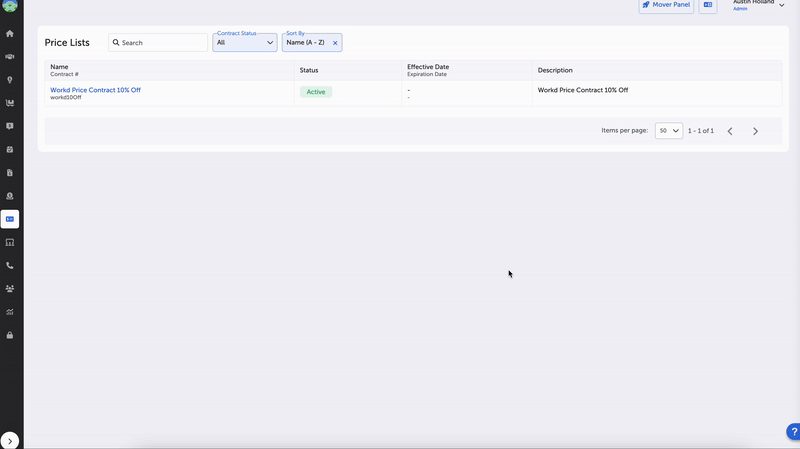Prices - Old
All users have access to Contract Pricing, but specific information displayed is based upon role (e.g., salespersons can view Contract Pricing for their own customers only).
In the past, users could only override an item’s default price relative to one customer by using the Set Price feature found in Clients --> Prices --> Saved Prices.
Now, in addition to setting a custom price in SupplyMover, users can designate contract pricing for specific customers and items via their ERP. Those designations are viewable in SupplyMover CRM and the E-commerce portal.
Price Lists are designed in a tier structure and include groups of customers and items. Based upon business decisions, a client may choose to assign specific customers to tiers with custom pricing based on many factors (e.g., customer sales volume, loyalty, item trends, negotiation, etc.).
Contract Pricing can be applied to Customers and Leads as business needs dictate.
Users can view all Contract Pricing Lists by navigating to main menu Prices --> Price Lists page, and the following information is displayed:
- Name, Contract # (hyperlink to Price List Details page; see below)
- Status (Active or Inactive)
- Effective Date, Expiration Date
- Description
- Priority
The Price Lists page can be searched, filtered, and sorted in the following ways:
- Search (keyword)
- Filter by Contract Status (dropdown):
- All
- Active
- Inactive
- Sort By (dropdown):
- Name (A - Z)
- Name (Z - A)
- Contract # (A - Z)
- Contract # (Z - A)
- Expiration Date (New - Old)
- Expiration Date (Old - New)
- Effective Date (New - Old)
- Effective Date (Old - New)
- Priority
Price Lists are not created in SupplyMover. Clients create Price Lists in their ERP, and it is viewable in SupplyMover.
When users select a specific Price List hyperlink, the Price List Details page is displayed and includes the following information:
Header:
- Contract Name
- Description
Price List Details:
- Status (Active or Inactive)
- Effective Date (if date given, then contract price will be given through designated period)
- Expiration Date (if no date given, then contract price will continue indefinitely)
- Priority Level (if a customer is eligible for more than one Price List, then the designated Priority Level will determine which contract price will be applied; an item with a Saved Price is Priority Level zero and supersedes all others)
- Description
Applied To (contract applied to designated items):
- Search and Sort:
- Search keyword
- Sort By (dropdown)
- Table displays:
- Name, Manufacturer (hyperlink to Item Details page)
- Item #
- Min. Order Amt. (criteria/condition that requires a minimum amount ordered to get contract price for item; if field is empty, then there is no minimum amount order requirement to get the contract price)
- Price:
- Price
- Trend (up/down) in dollars relative to various data points (e.g., list price, cost, or fixed amount) (color-coded)
Clients Under Price List (list of clients that are receiving contract price):
- Search, Filters, and Sort:
- Search keyword
- State (dropdown)
- Sales Rep (dropdown)
- Alternate Rep (dropdown)
- Lead / Customer (dropdown)
- Sales Status (dropdown)
- Sort (dropdown)
- Table displays:
- Client, Address:
- Client name (hyperlink to Client Details page)
- Street # and name
- City, State Zip
- ERP #
- Lead/Customer, Business Type
- Sales Rep, Alternate Rep
- Client, Address:
Things to Consider:
- An Item with a Saved Price is Priority zero, and as such, will override any contract.
- Customers can be on multiple Price Lists.
- Price Lists and Priority Level can only be set in ERP – viewable in SupplyMover.
- If an item is not on a Saved Price or Contract Price, then it defaults to list price.

Users can find the Customer Prices page by navigating to Clients --> select specific Customer --> Prices. The following information is displayed:
Header:
- Client Name (Customer # | ERP #)
- Street # and Name, City, State Zip
Price Lists:
- While hovering, displays Pricing Rule applied and can include one of the following options:
- Priority
- Lowest price, regardless of the priority
- Search, Filter, and Sort:
- Keyword search
- Contract Status (dropdown):
- All
- Active
- Inactive
- Sort By (dropdown):
- Name (A – Z)
- Name (Z – A)
- Contract # (A – Z)
- Contract # (Z – A)
- Expiration Date (New – Old)
- Expiration Date (Old – New)
- Effective Date (New – Old)
- Effective Date (Old – New)
- Table Properties:
- Name, Contract # (hyperlink to Price List Details page)
- Status (Active or Inactive)
- Effective Date, Expiration Date
- Priority Level (if a customer is eligible for more than one Price List, then the designated Priority Level will determine which contract price will be applied)
- Description
Items with Saved Prices:
Please refer to “Saved Prices” in the Items or Clients knowledge base for further information.
Things to Consider:
- An Item with a Saved Price is Priority zero, and as such, will override any contract.
- Customers can be on multiple Price Lists.
The Target column displays an info icon that displays additional details when hovering:
- Contract #: Contract Name (hyperlink)
- Trend (up/down) in dollars relative to various data points (e.g., list price, cost, or fixed amount) (color-coded)
If a customer is eligible for a contract price for an item based on Minimum Quantity Ordered, then once the quantity meets or exceeds the threshold, then the price will convert.
If an E-Commerce user receives Contract Pricing, the price displayed in the portal will be the price set on the Contract instead of list price.
Updated 8 months ago
